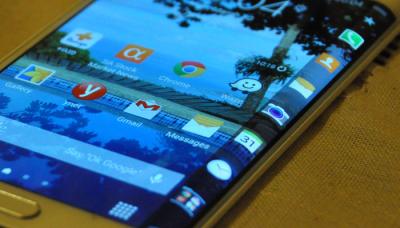Super AMOLED: introduction and market status
OLED displays use organic materials that emit light when electricity is applied. OLEDs enable emissive, bright, thin, flexible and efficient displays. OLEDs are replacing LCDs in most display applications - from smartphones and wearables to monitors and TVs.

Samsung's Super AMOLED displays, announced in 2010, are AMOLED displays for mobile devices (such as smartphones, wearables and tablets) with an integrated touch function. The thickness of the touch sensor is just 0.001 mm and this allows the screen to provide better images and to have great visibility even in direct sunlight compared with regular AMOLED displays with an external touch layer.
Samsung is producing hundreds of millions of Super AMOLED displays today, used mostly in smartphones, but also in other devices. These are considered to be some of the best displays on the market.
Super AMOLED and the Pentile matrix
Samsung's Super AMOLED displays use a Pentile matrix sub-pixel design. That means that the green sub-pixel is shared by two pixels and the display has only 2 sub-pixels per real 'pixel' compared to the classic RGB matrix design (or Real-Stripe). You can see a PenTile matrix vs a Real-Stripe one on the images below (the PenTile is on the right). Newer Super AMOLED displays use a different PenTile matrix (Diamond Pixel pattern).
Super AMOLED vs Dynamic AMOLED
In 2019 Samsung introduced its next-generation mobile display technology, which it calls Dynamic AMOLED. Basically a Dynamic AMOLED is similar to a Super AMOLED display, but it adds HDR support. Samsung's highest end smartphones adopt the company's Dynamic AMOLED 2X LTPO AMOLED displays.
Further reading
- Introduction to OLEDs
- Samsung's OLED displays
- Pentile Technology explained
- Flexible OLEDs
- OLED mobile phones
- The OLED Toolbox: a one-stop-shop for OLED information, insights, analysis and guides
Samsung will launch the Galaxy S for over 100 wireless providers worldwide
Samsung announced that they have ambitious plans for the Galaxy S launch - they have agreements with over 100 wireless providers, including the four key US carriers. We know that Samsung is not able to meet demand for its AMOLED displays, it'll be interesting to see whether they Galaxy S will be in short supply as well...

The Galaxy S has a 4" (800x480) Super-AMOLED display, runs Android v2.1, has a 1 Ghz processor and can shoot shoot HD video (720p) with a 5mp camera.
Rumors of a new Samsung Super-AMOLED Vodafone LiMo handset
There are rumors that Samsung are working on a new WVGA super-AMOLED LiMo phone for Vodafone, to be called the i8330 H2. It will come pre-loaded with Vadafone's 360 services and feature HSDPA, Wi-Fi, GPS, 8mp camera, HD video recording and a 1Ghz processor.
 Samsung i8330 H2
Samsung i8330 H2
Back in 2009, Samsung introduced the 360 H1 phone for Vodafone.
The new Sidekick phone to have a 4.3" Super-AMOLED?
There are rumors that T-Mobile's upcoming new Sidekick phone (project Emerald, to be known as the Sidekick twist) will run Google's Android v2.1, and have a large 4.3" super-AMOLED display. It's expected to be released in the summer.
The Samsung Super-AMOLED S8500 Wave to ship in the UK within 1-3 months for £349.99 unlocked
Samsung's super AMOLED
packing S8500 Wave phone is now available unlocked for £350 in the UK. Amazon say it'll ship within 1-3 months... We don't have a US release date yet. This will be the first shipping phone with a Super-AMOLED display.
 Samsung Wave s8500
Samsung Wave s8500The wave is running the Bada-OS, has a 3.3" 800x480 super-AMOLED display, and is also the first phone with Bluetooth 3.0. Other features include Wi-Fi, a 1Ghz processor, 5Mp camera, a-GPS, accelerometer, 2GB/8GB of internal memory, micro-SD slot
DivX/XViD support and 720p recording/encoding.
Samsung's S-Pad tablet to have a 7" Super-AMOLED?
Samsung's upcoming tablet computer, the S-Pad is confirmed for the second half of 2010 (some report an August release). There are rumors that this tablet will run on Google's Android OS and have a 7" Super-AMOLED (touch) display. Other features include Wi-Fi, 3G (SK Telecom in Korea) and USB connectivity.
This is interesting news. Currently, the largest super-AMOLED display is the 4" used in the Galaxy S smartphone. We know that Samsung are working on 7" AMOLEDs (they'll use one in the 700Z photo frame).
Samsung's S8500 Wave Super-AMOLED Bada phone now available in the UK
Samsung's Super AMOLED S8500 Wave phone is now available for UK's T-Mobile network. You can get it unlocked for £366.99. With a plan the handset ranges from £59.99 to free, depending on the monthly payments.
 Samsung Wave s8500
Samsung Wave s8500The Wave has a 3.3" 800x480 Super AMOLED display and runs Samsung's Bada OS. That's a world first on both. It also sports Bluetooth 3.0, Wi-Fi, 1Ghz processor, 5Mp camera, a-GPS, 720p recording/encoding and DivX/XviD support.
Samsung's Super-AMOLED Wave to be the first phone certified for DivX HD
Samsung announced that the Super-AMOLED packing Wave will be the first phone with certified support for DivX HD playback. The Galaxy S (with its 4" Super-AMOLED) will also be certified to play back the format.
 Samsung Wave s8500
Samsung Wave s8500 Samsung to announce a new Super-AMOLED phone and content deals
There are reports that Samsung are set to announce a new Super-AMOLED phone soon (in the CTIA exhibition). The phone will be called the Galaxy S and it'll run Android on a 1Ghz processor.
Samsung are also working on "Super AMOLED optimized" content: full-length movies and TV shows and also books and magazines. Sounds interesting.
Samsung is said to be developing a 'Super-AMOLED' WP7 phone
Samsung is said to be developing a new Windows Phone 7 (WP7) device, and it will have a Super-AMOLED touch display. It will also have 8mp camera, Wi-Fi, 3G and A-GPS. This isn't surprising as Microsoft are expecting most WP7 phones to have AMOLEDs.
We'll wait for an official announcement.
Samsung expects to sell around 10 million Wave phones in 2010
Samsung are going to push the new Wave phone (with the Super AMOLED and Bada OS) - it will be available in 50 countries by May and Samsung will offer developer support in 20 countries. They hope to get at least 1000 Bada apps by the end of 2010, and expects to sell around 10 million Wave phones in 2010.
 Samsung Wave s8500
Samsung Wave s8500
"We want to push feature phones into the mass market, and get feature phone users into smartphones." says Samsung. Bada is important to Samsung, but they are pursuing a multi-platform strategy, and they are not diverting resources from competing handset platforms such as Android.
Pagination
- Previous page
- Page 26
- Next page



